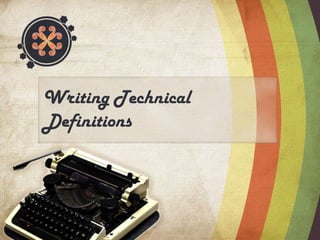
Writing technical definitions
- 2. Technical Definitions Describe and define new products and services Introduce new information to reader in clear and effective ways Allow experts and specialists to communicate with a more generalized audience
- 3. Planning for Audience (p. 453) Identify stakeholders Determine the amount and kind of technical language or jargon to use Acknowledge differences in language
- 4. Planning for Problem & Purpose (p. 454) Explanatory Definitions To explain a concept, thing, or idea to readers Operational Definitions To enable audiences to engage in an activity or operation Deliberative Definitions To clarify the meanings of terms, ideas, and concepts
- 5. Types of Definitions Short, Parenthetical & Extended
- 6. Short Definitions Are typically only a sentence or two to provide meaning for the reader Are usually categorical, placing the term in a category of similar terms May provide descriptions of use or other distinguishing characteristics of the term
- 7. Parenthetical Definitions Are typically only a sentence or two to provide meaning for the reader Are usually categorical, placing the term in a category of similar terms May provide descriptions of use or other distinguishing characteristics of the term
- 8. Extended Definitions May use the different kinds of definitions outlined earlier, like descriptions or visuals Exist in lengthier texts where audiences need detailed information
- 10. Researching Definitions Is often necessary to construct definitions that deal with unfamiliar ideas and concepts Produces more accurate and effective definitions
- 11. Drafting Definitions Includes putting together an initial definition and placing it in the context of the document Involves fitting the definition into the scope of the document This is harder than it seems – where does it fit and how? Where would you put this so it made sense for your audience and purpose?
- 13. Kinds of Definitions Definitions that describe Definitions that compare and contrast Definitions that classify Definitions that provide examples Definitions that illustrate with visuals
- 14. Definitions that Describe Often work by describing what something looks like, feels like, sounds like, or smells like Often appeal to the readers’ visual senses by describing size, shape, and appearance Often describe what the thing does, how it is used, and to what purpose
- 15. Definitions that Describe Example: Aielron: A small, slender, hinged section on the outer portion of a wing, used to control an aircraft’s rolling and banking movements. Ailerons usually work in opposition: as the left aileron is deflected upward, the right is deflected downward, and vice versa.
- 16. Definitions that Compare & Contrast Give similarities or differences between subjects Often compare or contrast something unfamiliar with something the audience knows Provide a frame of reference by giving context
- 17. Definitions that Compare & Contrast Example: Flash Drive: A small, lightweight, portable Universal Serial Bus (USB) device that allows users to store, carry, and transfer programs and files, much like the older 3.5-inch floppy disk. The flash drive, however, differs from the older floppy disks; it is much smaller (only 70 mm long, 30 mm wide, and about 11 mm in height) and more durable and contains no internal moving parts.
- 18. Definitions that Classify Categorize a term within a larger group in order to provide a context or association Can be problematic because not everyone agrees on the meaning of particular categories
- 19. Definitions that Classify Example: Someone writing a field guide to birds and animals in Texas could safely assume that many people would not know what an ocelot is. However, if the writer begins by defining an ocelot as a kind of wildcat, much of the mystery of the term disappears because most if not all readers can identify a wildcat.
- 20. Definitions that Provide Examples Provide a clear-cut and familiar example of the thing or concept being defined Should use examples familiar to the audience Frequently clarify abstract terms
- 21. Definitions that Provide Examples Example: Sports car might be defined as vehicles with sleek body styles, superior acceleration, little cargo space, and so forth. While such a definition would be useful, any definition of sports car would benefit by providing specific examples: Chevrolet Corvette, Dodge Viper, or Porsche 911, for example.
- 22. Definitions that Illustrate with Visuals Give readers visual prompts to give clear and quick understanding Benefit the reader by including a picture in addition to a written definition Help explain concepts that one cannot actually see with the naked eye
- 23. Definitions that Illustrate with Visuals
- 25. Ethics in Technical Definitions Be aware of how definitions can potentially mislead, confuse, or cause danger or harm. Ensure that readers have all the information necessary to use the product safely. Rely on correct, unbiased information to help audiences make decisions.
- 26. Ethics in Technical Definitions Full Disclosure Writers have not omitted any information that an audience needs to comprehend the term Appropriate Style Select a style that should be clearly grasped by the target audience
- 27. Common Mistakes Circular Definitions Using the term in defining it Synonyms Using a similar term gives no useful information Not User-Oriented Failing to take the users’ or audiences’ knowledge, background, and needs into account
- 29. Steps: Identify the topic of your technical definition Identify your audience Identify purpose of definition (explanatory, operational, deliberative) Select the type of combination of types of definitions that will work best for your topic, audience, and purpose. Research your topic Draft and Revise (pg 458)
